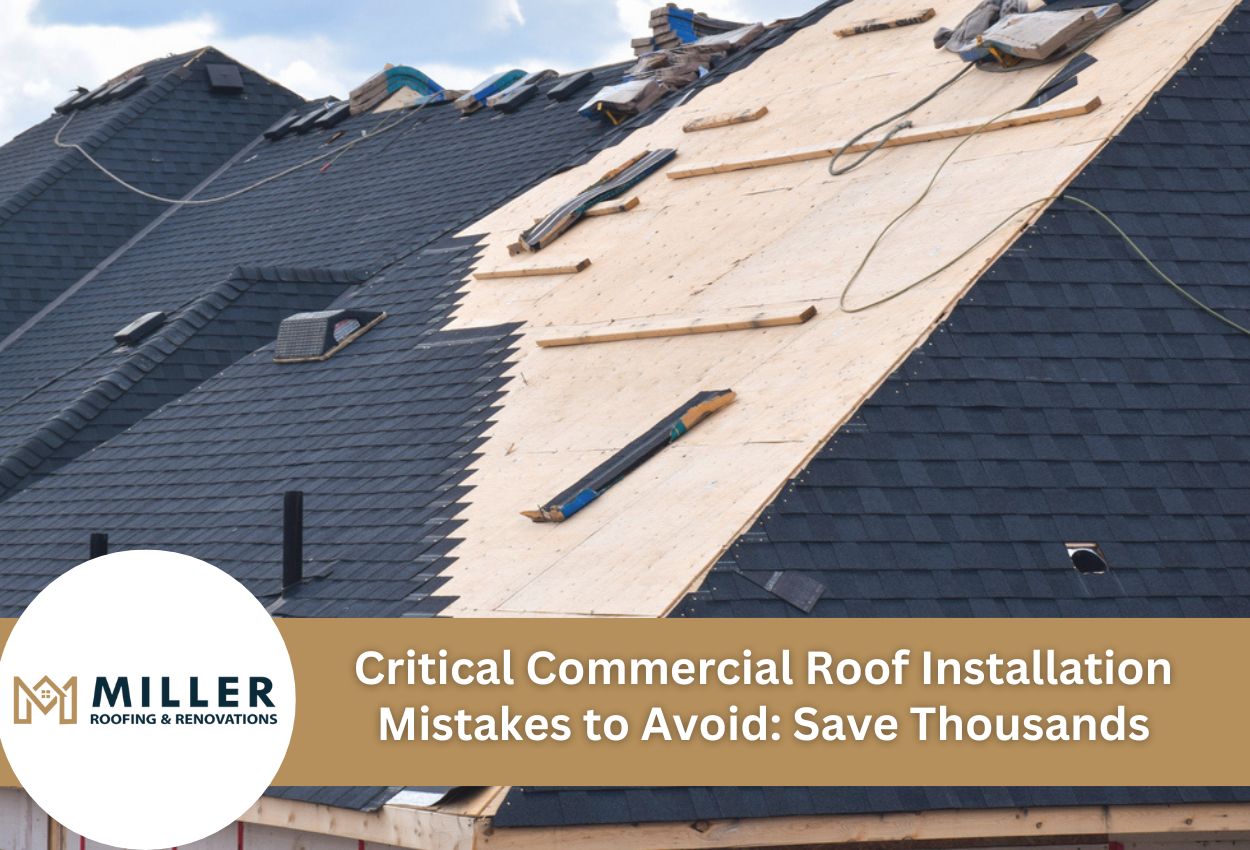If errors are made during a commercial roof installation, it can slowly drain the building owner’s budget through unexpected repairs, increased energy consumption, and disruptions to daily business operations. For Memphis business owners, the stakes are particularly high due to the region’s challenging climate conditions. With high humidity levels, frequent heavy rainfall, and occasional severe weather events, proper roof installation isn’t just recommended, it’s essential for long-term building protection.
Many building owners don’t realize that installation mistakes with flat roofing membranes, such as TPO or EPDM, can lead to systematic failures that show up months or even years after completion. These problems typically begin small but expand into major structural concerns that threaten business continuity and require extensive remediation.
The most expensive commercial roofing installation errors often stem from poor contractor selection, inadequate material choices, or improper application techniques. When membrane seams fail or flashing is incorrectly installed around roof penetrations, leaks become inevitable, especially during Memphis’s intense summer thunderstorms and winter rain.
Understanding the common mistakes that occur helps business owners make informed decisions when planning roof installations or replacements. By identifying potential problems before they occur, businesses can avoid the financial burden of premature roof failure and maintain their operations without weather-related interruption.
Improper Drainage System Design and Installation
Poor drainage is one of the most damaging commercial roof installation mistakes in Tennessee. With Memphis averaging over 50 inches of rainfall annually, calculating the slope incorrectly can often lead to standing water that weighs down roof structures and breaks down roofing materials prematurely. Even minimal ponding water can add hundreds of pounds of weight to sections of the roof, causing structural stress and accelerating membrane deterioration.
Drainage problems also typically stem from inadequate planning during the design phase. Commercial flat roofs require that their slope is precisely calculated, which is generally around a minimum of 1/4 inch per foot, in order to channel water toward drains. Without the right pitch, water collects in depressions, particularly around HVAC equipment and other roof penetrations.
Equipment failures also contribute significantly to drainage issues. Clogged or improperly installed drains, undersized scuppers, and damaged gutters prevent water from properly exiting the roof’s surface. In TPO and EPDM installations, contractors sometimes position drains incorrectly or fail to create the right slope with tapered insulation.
Professional commercial roofing contractors are able to prevent these problems through thorough drainage plans that account for the building’s specific needs and local weather patterns. Proper installation includes strategic placement of primary and overflow drains, regular maintenance access points, and correctly sized downspouts that can handle Tennessee’s heavy downpours without backing up onto the roof’s surface.
Membrane Selection and Application Errors
Selecting the wrong membrane for local weather conditions represents one of the most expensive mistakes you can make in commercial roofing. Our region’s combination of high UV exposure, humidity, and temperature fluctuations demands membranes specifically engineered to withstand these challenges. TPO membranes may prematurely crack if not properly formulated for intense sun exposure, while incorrectly specified EPDM might shrink excessively during Memphis’s temperature swings, pulling away from perimeters and penetrations.
Installation errors only make a poor choice even worse. Commercial roof membrane installation problems frequently include the wrong techniques utilized to seal seams that compromise waterproofing. With TPO, contractors sometimes use incorrect welding temperatures or speeds, creating weak spots that allow moisture in. EPDM seams must be thoroughly cleaned before adhesive is applied as well, a step often rushed during hot Memphis summers when adhesives dry quickly.
PVC membrane installations fail when contractors neglect to properly prepare the roof deck or use incompatible materials together. Errors in fastener placement can also create pathways for water entry, particularly during heavy rain that is common to our region. The resulting leaks that occur typically remain hidden until significant damage has occurred beneath the membrane.
Professional commercial roofing contractors prevent these issues by matching membrane specifications to Memphis’s climate requirements and following manufacturer-certified installation procedures. This attention to detail ensures commercial roofing systems perform as designed throughout their expected service life, protecting businesses from expensive emergency repairs.
Failures With Flashing and Sealant
Improper flashing around roof penetrations stands as one of the leading causes of commercial roof leaks in Memphis and throughout Tennessee. Every vent pipe, HVAC unit, skylight, and other penetration creates a vulnerable point where water can enter the building if it’s not properly sealed. These critical areas require specialized techniques beyond simply applying roof membrane material, yet they’re frequently mishandled during installation.
Failure tends to occur when contractors use incompatible materials or incorrect application methods. Metal flashing should be properly integrated with the chosen roof membrane through specific transition techniques that account for different rates of expansion and contraction. When Memphis temperatures fluctuate between summer heat and winter cold, these materials expand and contract at different rates, pulling apart flashing that was already incorrectly installed.
Sealing a commercial roof penetration requires creating watertight barriers that can withstand Tennessee’s seasonal changes. This includes using appropriate counterflashing, pitch pockets with pourable sealants for irregular penetrations, and proper membrane termination details.
Professional commercial roofing contractors prevent these issues by following manufacturer-specific protocols for each type of gap in the roof they come across. They understand that seemingly minor details like proper termination bar attachment or correct sealant depth along expansion joints directly impact system performance. By maintaining watertight integrity at these critical transition points, building owners avoid the internal damage and business disruption that penetration failures inevitably cause.
Roof Deck Preparation Shortcuts
Cutting corners during substrate preparation is a critical mistake that plagues many commercial roofing projects in the Memphis area. Before any new membrane installation, thorough inspection and preparation of the roof deck help craft the foundation for the entire system’s performance. Unfortunately, many contractors rush through this vital step to save time, creating hidden problems that emerge months after the project is completed.
A low-quality roof deck inspection often misses structural issues like deteriorated wood, corroded metal, or concrete spalling that compromise the integrity of the entire roofing system. When these underlying problems remain unaddressed, they continue deteriorating beneath the new membrane, creating unstable areas that accelerate wear and eventually lead to failure, even when premium materials are used on top.
Proper roof deck cleaning and preparation directly impact adhesion strength, particularly with fully-adhered commercial systems. Dust, oils, moisture, and debris prevent the membrane from properly bonding to membranes and substrates. Similarly, failing to treat existing roof decks with appropriate primers creates weak points that easily become vulnerable to wind uplift — a serious concern during Tennessee’s severe weather events.
Reputable commercial roofing contractors invest the necessary time in thorough deck preparation, including proper repair, removal of contaminants, and application of manufacturer-specified primers. This methodical approach creates the stable foundation necessary for long-term performance of TPO, EPDM, and other commercial roofing systems, preventing premature failure and protecting building investments.
Contractor Qualification and Project Management Pitfalls
Selecting the wrong commercial roofing contractor is one of the most consequential decisions in the entire roofing process. In Memphis, where weather conditions demand precise installation techniques, contractor qualifications directly impact the roofing system’s performance and longevity. Building owners should verify multiple credentials before hiring, including proper licensing with the Tennessee Board for Licensing Contractors, adequate insurance coverage, manufacturer certifications for specific systems, and documented experience with similar projects in the Mid-South region.
Warning signs of problematic contractors often appear early in the process. Be wary of those who provide minimal documentation, resist putting specifications in writing, or cannot produce references from commercial projects completed within the past three years. Contractors who lack manufacturer certifications typically don’t receive ongoing training on evolving installation techniques, particularly important with TPO and EPDM systems that require specialized knowledge.
Poor project management shows itself through inconsistent crew supervision, inadequate quality control processes, and minimal documentation during installation. Professional contractors use systematic quality checks at critical installation phases, particularly for concealed components that become inaccessible after project completion. They also maintain detailed records of material batch numbers, installation dates, and testing results that protect building owners if issues arise.
Maintenance Planning Oversights During Installation
Many commercial building owners focus exclusively on the installation process without establishing critical maintenance protocols that protect their roofing investment long-term. This oversight during the Memphis installation phase significantly reduces the lifespan of the roof and leads to preventable failures. When contractors complete installation without providing maintenance documentation or scheduling the first inspection, building owners often remain unaware of their maintenance responsibilities until problems develop.
Proper maintenance planning during installation includes creating detailed roof documentation packages with specific information about installed materials, system components, and maintenance requirements. These documents should identify inspection points on TPO and EPDM membranes, drainage pathways requiring regular clearing, and expansion joints needing periodic examination. Without these resources, maintenance teams lack the guidance to care for commercial roofing systems.
Roof warranties are another critical aspect often overlooked during installation. Many commercial roofing warranties require documented maintenance to remain valid. Building owners who fail to establish these protocols during installation risk voiding manufacturer guarantees that would otherwise protect against defects or premature failures, saving money.
Professional commercial roofing contractors incorporate maintenance planning into every installation project. They provide comprehensive documentation, establish maintenance schedules aligned with warranty requirements, and educate building management teams on proper roof care.
Avoid Expensive Commercial Roof Installation Mistakes with Miller Roofing and Renovations
Ensuring your commercial roof is properly installed is crucial, especially in the challenging Memphis climate. Don’t let common commercial roof installation mistakes jeopardize your investment. Call Miller Roofing and Renovations today at (901) 457-9405 to ensure your roof is installed correctly and efficiently, providing you with peace of mind and long-term savings.



 FREE ESTIMATE
FREE ESTIMATE